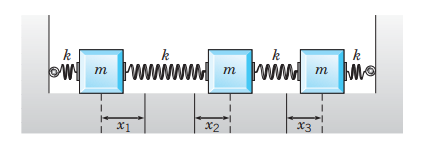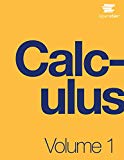
Concept explainers
Derive the system of equations (1) by applying Newton’s second law,
The system of equations describing motions of a three mass and four spring system by applying Newton’s second law

Answer to Problem 1P
Solution:
The system of equations describing motions of a three mass and four spring system are
Explanation of Solution
Given information:
Three masses
Newton’s second law is
The springs follow Hooke’s Law: The force exerted by a spring on a mass is directly proportional to the length of its departure from its equilibrium length.
Explanation:
The first mass’s one side is attached to the wall with the spring and the other side is attached to the second body with another spring of spring constant
Then the velocity of the mass is
Then the acceleration of the mass is
By Newton’s law, the forces acting on the mass is
By Hooke’s law, the forces acting on the mass is
Also, a force
Then the equation of motion of the first body is
In the second case, the second body is attached to the first body with the spring and the other side is attached to the third body with another spring of spring constant
Then the velocity of the mass is
Then the acceleration of the mass is
By Newton’s law, the forces acting on the mass is
By Hooke’s law, the forces acting on the mass is
Also, a force
Then the equation of motion of the second body is
Similarly, in the third case, the third mass is attached to the wall with the spring and in the other side, it is attached to the second body with another spring of spring constant
Then the velocity of the mass is
Then the acceleration of the mass is
By Newton’s law, the forces acting on the mass is
By Hooke’s law, the forces acting on the mass is
Also, a force
Then the equation of motion of the third body is
Thus, the system of equations describing the motions of a three mass and four spring system are
Want to see more full solutions like this?
Chapter 6 Solutions
Differential Equations: An Introduction to Modern Methods and Applications
Additional Math Textbook Solutions
Calculus Volume 1
A Problem Solving Approach To Mathematics For Elementary School Teachers (13th Edition)
Thinking Mathematically (7th Edition)
Calculus Volume 2
Excursions in Modern Mathematics (9th Edition)
Mathematics with Applications In the Management, Natural and Social Sciences (11th Edition)
- A 1-kilogram mass is attached to a spring whose constant is 24 N/m, and the entire system is then submerged in a liquid that imparts a damping force numerically equal to 11 times the instantaneous velocity. Determine the equations of motion if the following is true. (a) the mass is initially released from rest from a point 1 meter below the equilibrium position (b) the mass is initially released from a point 1 meter below the equilibrium position with an upward velocity of 11 m/sarrow_forwardExplain theorem of General Solutions of Homogeneous Systems?arrow_forwardHow method of elimination for linear differential systems is similar to thesolution of a linear system of algebraic equations?arrow_forward
 Discrete Mathematics and Its Applications ( 8th I...MathISBN:9781259676512Author:Kenneth H RosenPublisher:McGraw-Hill Education
Discrete Mathematics and Its Applications ( 8th I...MathISBN:9781259676512Author:Kenneth H RosenPublisher:McGraw-Hill Education Mathematics for Elementary Teachers with Activiti...MathISBN:9780134392790Author:Beckmann, SybillaPublisher:PEARSON
Mathematics for Elementary Teachers with Activiti...MathISBN:9780134392790Author:Beckmann, SybillaPublisher:PEARSON
 Thinking Mathematically (7th Edition)MathISBN:9780134683713Author:Robert F. BlitzerPublisher:PEARSON
Thinking Mathematically (7th Edition)MathISBN:9780134683713Author:Robert F. BlitzerPublisher:PEARSON Discrete Mathematics With ApplicationsMathISBN:9781337694193Author:EPP, Susanna S.Publisher:Cengage Learning,
Discrete Mathematics With ApplicationsMathISBN:9781337694193Author:EPP, Susanna S.Publisher:Cengage Learning, Pathways To Math Literacy (looseleaf)MathISBN:9781259985607Author:David Sobecki Professor, Brian A. MercerPublisher:McGraw-Hill Education
Pathways To Math Literacy (looseleaf)MathISBN:9781259985607Author:David Sobecki Professor, Brian A. MercerPublisher:McGraw-Hill Education





